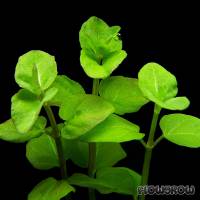



This rather little known stem plant was brought into trade under the erroneous name "Lindernia anagallis" probably in Japan, and it was also spread among hobbyists in the USA. In Europe. It is also quite frequently sold in Europe since at least 2009. It resembles the true Lindernia anagallis from tropical and subtropical Asia but it is Clinopodium brownei, Browne's savory, from the Americas. Its species identity was initially uncertain, therefore its name was written Clinopodium cf. brownei.
This species, also known as Micromeria brownei, is found as terrestrial and wetland plant in moist to wet locations in the US states along the Gulf of Mexico, as well as in vast parts of Central and South America. It is placed in the same genus as the Wild basil, Clinopodium vulgare, that occurs in dry places in Europe.
Clinopodium brownei effuses a strong peppermint smell when bruised. Its stems are tetragonal, the alternate leaves have a stalk and are widely ovate, their margin notched. They have an about 1,5 to 2,5 cm long leaf blade on a ca. 1 cm long petiole. All in all, the plant looks a bit like moneywort (Lysimachia nummularia), however, the latter has an entire margin, not a notched one, and it does not smell of mint.
Its emersed form has a creeping to ascending growth habit, the submersed form grows upright and has a rather small number of lateral shoots. Stems and leaves are green.
For further information, see under "Culture" and "Design".
Clinopodium brownei is not a very demanding plant regarding water quality in the aquarium. Hans-Georg Kramer (2010) had good success in cultivating it in water with a very low (>1 °dH) as well as in water with a moderate carbonate hardness (ca. 9 °dH), however, growth was healthiest under moderate light. He also found that the plant needs a relatively high level of macronutrients; a nutrient deficiency shows in stunted growth of the leaves.
Under favourable conditions, this plant has a growth rate of around 3 cm per week. Before the stems reach a length of around 40 to 45 cm, the shoot tips should be cut off and re-planted, as the main shoot will stop growing any longer and also won't ramify very well (Kramer 2010).
When cultivated emersed on wet substrate, the plant will grow lushly, and under sufficient light it will even form small whiteish to pale purple flowers in the leaf axils near the shoot tip. During the warm months, it can be planted outdoors, too, where it will form creeping to overhanging stems e.g. in mobile containers.
For further information, see under "Design".
Browne's savory has upright stems and light-green foliage, looking best as a group in the midground to background of an aquarium, contrasting well with dark green and brown-red plants. Clinopodium brownei also grows easily in its creeping terrestrial form in moist bottom and should be interesting for emersed setups such as paludariums and Wabi-Kusa where one may expect its small, white and mauve flowers.
<a href="https://www.flowgrow.de/db/aquaticplants/clinopodium-brownei" target="_blank"><img alt="Clinopodium brownei" title="Clinopodium brownei" src="https://www.flowgrow.de/db/widget/aquaticplants/clinopodium-brownei" /></a>
[url=https://www.flowgrow.de/db/aquaticplants/clinopodium-brownei][img]https://www.flowgrow.de/db/widget/aquaticplants/clinopodium-brownei[/img][/url]
[widget=aquaticplants/clinopodium-brownei]Clinopodium brownei[/widget]